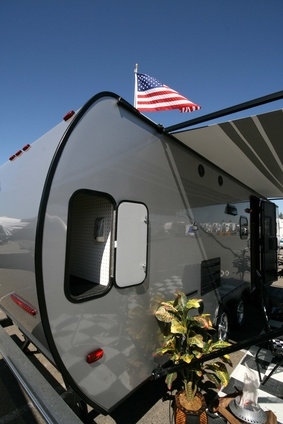
The fresh water components in RVs and travel trailers provide utility and drinking water through a self-contained system that requires periodic checks and maintenance. In-line filters screen out foreign particles and harmful chemicals. Water pumps provide the pressure to feed the faucets and septic system, while the tank holds the main supply of fresh water. The water pump has a preset feature that allows it to run whenever a faucet opens and maintain line pressure. It automatically shuts off when pressure has been restored. Troubleshooting the water pump and tank system requires working knowledge of a few operational components and some inspection steps.
Chock the wheels on the trailer, front and rear. Use a five-ton commercial trailer jack to lift one side of the trailer for access to the undercarriage. Check for leaks, starting at the external fresh water intake line. Follow the intake lines to the tank or the system faucet plumbing under the trailer. Some trailers have dual-intake lines: one going to the faucet plumbing, and the other to the fresh water tank. Check all lines and joints for leakage.
Use a screwdriver or socket to remove the protective tank panel under the trailer. Pull back any insulation. Look for dampness in the insulation for signs of leakage. Inspect the water tank's inlet connection for proper tightness and dryness. Examine any inline filter for leaks at the hose connections. Replace any in-line fuel filter by loosening the hose clamps with a screwdriver (if your faucets exhibit low pressure with a normal running water pump).
Locate the trailer's main battery box. Unclasp the access panel snaps. Take the red (positive) lead of a multimeter and place it on the primary battery red terminal. Place the black (negative) lead of the multimeter to a good metal ground source. Set the gauge for volts -- it should read between 12.6 to 12.7 volts. If it reads below 12 volts, the battery has a 50 percent discharge rate or lower. Charge the battery to allow full water pump operation.
Look for your battery disconnect switch on the trailer's panel; make sure it shows the "on" position. Look for your main fuse box, also called the power distribution box. Refer to the trailer's fuse schematic for the pump fuse or relay location. Examine the fuse for a broken filament, and replace it if defective. Exchange a good relay for the water pump relay, if so equipped with one. Use the proper amperage relay for testing purposes.
Locate the water pump by referring to your trailer owner's manual. Disconnect the power lead wiring going to the pump. Turn the cabin battery switch to the "on" position. Turn the water pump switch on. Clip the black (negative) lead of a 12-volt test light to a bare metal ground source.
Place the test light probe to the power wire (usually red) on the water pump wire jack. Check the ground wire from the water pump to the metal chassis. It must be clean and tight. If the light illuminates but the pump does not operate, the pump has an internal short and must be replaced, or rebuilt with a kit.
Look at the rubber mounting grommets that sit under the water pump, and attach to the trailer frame. The grommets serve as noise dampers. Loud pulsating noises coming from the water pump indicates worn or over-tightened pump mounting bolts. Use a socket and wrench to loosen the bolts a few turns, to allow more free play and pump movement. Replace any flattened or split grommets.
Refer to your trailer owner's manual for the location of your check valve or valves. A check valve keeps water from backing up from the pump side to the water tank. an external check valve keeps the outside water supply charging the lines with water. Disassemble the check valve with a screwdriver or socket to inspect the valve and spring condition. Replace any check valve that does not open or close properly.
Check for any moldy or stale odors from the sink faucets. Water odor indicates bacteria in the lines and tank. Use one cup of bleach for every 15 gallons of tank water. Add the bleach mixture to a full tank. Drain and refill it several times to decontaminate the water tank and lines.